
|
Sale 137
Pre-Long Beach Auction
| Lot |
Photo |
Description |
Realized |
Lot 1109 |
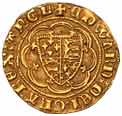 |
Great Britain. Quarter Noble, ND. S.1511; N-1244; Fr-97. 1.90g. Edward III, 1327-1377. Fourth coinage, treaty period (1361-1369), London, annulet before EDWARD. Reverse; Lis in center. Rare this nice. Pop 2; 1 in 64+; 1 in 65. Photo in the PCGS Pop Report. PCGS graded MS-64. Estimated Value $2,000 - UP
Ex Baldwin's Auction 43, Oct 11, 2005, lot 2259.
View details and enlarged photos
Realized
$3,600 |
|
Lot 1110 |
 |
Great Britain. Noble, ND. S.1502; Fr-95. 7.79g. Edward III, 1327-1377. Fourth Coinage. Treaty period (1361-1369). London mint. Saltire before Edward. King standing in ship with sword and shield. A crisply struck coin with a sharp portrait. The overall appearance is excellent. Pop 3; 3 in 64; 1 in 64+. PCGS graded MS-63. Estimated Value $5,000 - UP
Ex Goldberg Sale 34, Feb 5, 2006, lot 2204.
View details and enlarged photos
Realized
$16,200 |
|
Lot 1111 |
 |
Great Britain. Noble, ND. S.1503; Fr-95. 7.69g. Edward III, 1327-1377. Fourth coinage. Treaty period. London mint. Annulet before Edward. King standing in ship with sword and shield. This rare medieval gold coin is similar to the last piece, but is a slightly different variety. Another superb portrait. Fresh and well struck with some original luster. Pop 2; 2 in 64. This coin photo in the PCGS Pop Report. PCGS graded MS-63. Estimated Value $4,000 - UP
Ex Goldberg Sale 34, Feb 5, 2006, lot 2205.
View details and enlarged photos
Realized
$16,800 |
|
Lot 1112 |
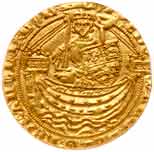 |
Great Britain. Half Noble, ND. S.1506; Fr-96. 3.81g. Edward III, 1327-1377. London mint. Treaty period. King in ship with sword and shield. The Half Noble is rarer in higher grades than the full Noble, but this is a truly exceptional specimen, well struck, without weakness, and a lovely round coin. Pop 1; The Finest graded at PCGS. This coin photo in the PCGS Pop Report. PCGS graded MS-63. Estimated Value $3,000 - UP
Ex Goldberg Sale 34, Feb 5, 2006, lot 2206.
View details and enlarged photos
Realized
$9,300 |
|
Lot 1113 |
 |
Great Britain. Half Noble, ND. S.1665; Fr-101. 3.47g. Richard II, 1377-1399. London. Ruler in ship. Reverse; Ornamental cross. This is a remarkably sharply struck example of a very rare coin. Pop 1; The Finest graded at NGC. NGC graded MS-62. Estimated Value $7,000 - UP
Ex Goldberg Sale 34, Feb 5, 2006, lot 2210.
View details and enlarged photos
Realized
$12,600 |
|
Lot 1114 |
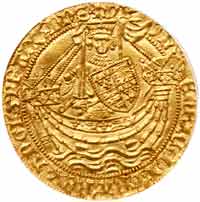 |
Great Britain. Noble, ND. S.1799; Fr-112. 6.93g. Henry VI, First Reign, 1422-1461. Annulet issue, 1422-1427. King standing facing in ship with sword and shield. Lots of original mint luster, a crisp bold strike and no areas of weakness. A fabulous coin. Pop 17; 14 Finer at PCGS. PCGS graded MS-62. Estimated Value $5,000 - UP
Ex Goldberg Sale 34, Feb 5, 2006, lot 2214.
View details and enlarged photos
Realized
$12,000 |
|
Lot 1115 |
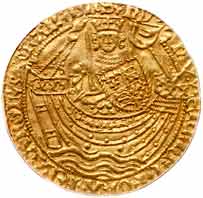 |
Great Britain. Noble, ND. S.1801; Fr-133. 6.68g. Henry VI, First Reign, 1422-1461. As the last type (S.1799) but Flemish imitative coinage. King standing in ship with sword and shield. This splendid continental copy of the English coin is probably much rarer than the issue produced in London. Very Collectible. Pop 2; Only 2 graded at PCGS. PCGS graded MS-62. Estimated Value $3,000 - UP
Ex Goldberg Sale 34, Feb 5, 2006, lot 2215.
View details and enlarged photos
Realized
$7,800 |
|
Lot 1116 |
 |
Great Britain. Ryal or Rose-Noble, ND. S.1952; Fr-133. Edward IV, First Reign, 1461-1470. Flemish imitative copy. A recognized and highly collected variety, this coin was probably produced in the 16th century. A superbly detailed specimen on a very large flan. PCGS graded MS-62. Estimated Value $3,000 - UP
Ex Goldberg Sale 34, Feb 5, 2006, lot 2220.
View details and enlarged photos
Realized
$12,600 |
|
Lot 1117 |
 |
Great Britain. Angel, ND. S.2187; Fr-151. 5.14g. Henry VII, 1485-1509. Mint mark pheon. Angel with foot on the dragon. Reverse; Ship with h and rose above quartered shield. Reverse design is inverted 180 degrees. Pop 2; None Finer at PCGS. This coin is photo in the PCGS Pop Report. PCGS graded MS-62. Estimated Value $5,000 - UP
Ex Goldberg Sale 34, Feb 5, 2006, lot 2222.
View details and enlarged photos
Realized
$10,800 |
|
Lot 1118 |
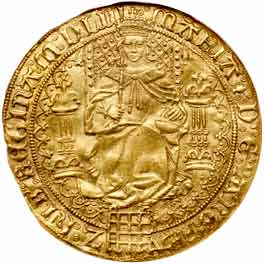 |
Great Britain. 'Fine' Sovereign, 1553. S-2488; N-1956. 15.27 grams. Mary Tudor, 1553-1554. Date in Roman Numerals. Mary enthroned facing. Reverse; Shield within rose. Pomegranate / pomegranate mintmarks. With a full flan, bold legends and a solid strike (including the queen's delicate face), this a most impressive hammered coin. Very rare, more so in this grade. NGC graded MS-61. Estimated Value $25,000 - UP
The death of Henry VIII's teenaged son, Edward VI, in July 1551 signaled not only the demise of the Tudor king's only male heir but what might have been a turning point in British history. The boy-king had been incapable of governing, which left control of the Crown to his statesmen in what was called the Protectorate, also known as his Council, consisting of men given power by Henry VIII. Each was overwhelmingly self-serving. When Edward died, the Duke of Northumberland, his Protector at the time, ignored King Henry's wishes and attempted to place his daughter-in-law, Lady Jane Grey, on the throne. Parliament and loyalists of the Tudor family intervened, ending in Lady Jane's beheading at the Tower and the succession of the late king's older sister Mary. She had her mind set to restore the fineness of the kingdom's coins (which had fallen to a poor state under her father) but her main objective was not improving the money, which she did, but rather inspiring loyalty from her subjects. For little more than a year, the kingdom thrived and was at peace. Then, in July 1554, she married Prince Philip of Spain, a Catholic. His image and name were placed on many of her coins, but his politics became a horror to the people of England. He brought the Spanish Inquisition to England, persecuting and killing many of Mary's formerly loyal subjects. She was dubbed "Bloody Mary" during the terror and might have been overthrown had she not died of stomach cancer. Philip made haste to return to Spain. The threat to England's historical movement towards freedom ended when the dead queen's little sister, the Princess Elizabeth, became Queen Elizabeth I. She quickly restored all of the money to high standards of quality, and her image and name replaced Mary's-whose greatest coin is seen in this "fine sovereign." In Elizabeth's long reign, the horror that Spain attempted to install in England was repaid when the English navy intercepted and destroyed the invading Spanish Armada in 1588.
Ex Dr Jacob Y. Terner Collection (by private treaty to the Millennia Collection). Illustrated in Money of The World, coin 82.; Ex Goldberg 'Millennia' Sale, 46, May 26, 2008, lot 289, previously in NGC holder graded MS-62, price realized $46,000.
View details and enlarged photos
Realized
$96,000 |
|
Lot 1119 |
 |
Great Britain. Milled Half Pound, ND. S-2543; N-2019. 5.69 grams. Elizabeth I, 1558-1603. Milled Coinage (1565-1570). Coinage by Mestrelle, the monarch in jeweled dress, with curly "Z" in her name, and grained edge. Crowned bust left. Reverse; Crowned, square-topped shield. Lis mintmark (struck 1567-1570, era of the 3rd Coinage). A splendid example, rich with luster and mellow golden red toning, on a broad flan and showing intricate design details. Few exist of this caliber! Extremely rare as such. Pop 1; The only Example graded. NGC graded MS-62. Estimated Value $30,000 - UP
Tower Mint, London. This coin features a famous coinage portrait of the queen wearing a ruff around her neck, her long hair seemingly studded with jewels, flowing from beneath her crown down the back of her neck, her dress elaborate and also jeweled. Her profile is dramatic and accurate to life. Above her near the rim is a "lis" initial mark. The reverse side shows a familiar motif that became the standard for her smaller gold coins: a quartered shield, crowned, holding the royal insignia, with her initials ER split to the sides. The "lis" again appears, here before one of Elizabeth's favored religious legends, in Latin SCVTVM FIDEI PROTEGET EAM, which in English means "The shield of faith shall protect her."
The "lis" initial mark signifies that this coin was minted 1566-70 as part of what is called Elizabeth's Third Coinage period. This was relatively early in her long reign at a time when she was determined to rectify the debasement of English money which began when her father, King Henry VIII, raided his own treasury to pay for his personal excesses, and they were numerous. By contrast, his daughter was almost stingy and her desire was that all English coins issued in her name would be of high quality-that is, of a fineness of metal that would inspire confidence in the money as well as loyalty to her as queen. She also commanded that her Royal Mint would fashion her money well, with a sharpness of design that would be consistently well detailed. At the time, coins were made using an ancient technique involving individual "moneyers" at the mint holding one die while the other was settled into a block; when a blank piece of metal was placed on the lower die, the coiner would place the upper die on it and strike it with a hammer, often more than once. This produced coins of inconsistent quality, sometimes sharp here or there, sometimes struck off center with areas of weakness of design.
About 1561 the Privy Council, which advised the queen and was the sole intermediary between the monarch and her various agencies of government, was approached by a man of great talent at minting-Eloye Mestrelle, a French moneyer who possessed some equipment that was not yet known in England. It was a "screw press" worked by two or more men who swung a long lever that caused the mechanism to close on a piece of metal held in place below it. The blank pieces of metal from which the coins were struck in this manner were made by another piece of machinery powered by a horse-drawn mill in another part of the mint. He called his novel money "mill" coinage, now known as "milled" by collectors. Elizabeth liked the idea and ordered her Privy Council to engage Mestrelle. He set up his equipment at the old Royal Mint inside the Tower of London and produced this special coinage from 1565-70. Unfortunately there was a downside to the story of his great success: the guild of old-time workers, who had hammered out coins for decades, felt so threatened by the Frenchman's inventiveness that they told their masters at the mint that the equipment was unreliable and slow, compared to their own work. They orchestrated Mestrelle's removal from the mint in 1572, but what was experimental in 1565 remained impressive to many eyes and within a century "milled coinage" would return and become the new standard in Great Britain.
Ex Dr Jacob Y. Terner Collection (by private treaty to the Millennia Collection). Illustrated in Money of The World, coin 84; Ex Goldberg "Millennia" Sale 46, May 26, 2007, lot 296.
View details and enlarged photos
Realized
$81,000 |
|
Lot 1120 |
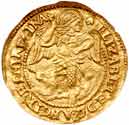 |
Great Britain. Half Angel, ND. S.2532; Fr-212. 2.46g. Elizabeth I, 1558-1603. Fifth Issue, 1583-1600. Mint mark, Bell (1582-3). St. Michael slaying dragon. Reverse; Cross and arms on ship. E and rose behind mast. Very difficult to obtain in grades above fine condition, this remarkable well struck example in this top quality make this a irreplaceable rarity. Pop 1; The Finest graded at NGC. Only one graded. NGC graded MS-63. Estimated Value $7,500 - UP
Ex Goldberg Sale 34, Feb 5, 2006, lot 2226.
View details and enlarged photos
Realized
$11,100 |
|
Lot 1121 |
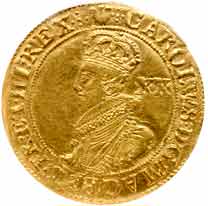 |
Great Britain. Unite, ND. S.2692. Charles I, 1625-1649. Tower mint, under the King, 1625-42. Mint mark, plume (1630-1). A scarcer variety and a very round coin, struck on a large flan. Third bust. Reverse has oval shield with C R at sides. In many ways this coin resembles a specially made or 'presentation' piece. Lots of original luster and a finely detailed portrait of the King make this an exceptional specimen. Pop 1; 1 in 55. Only 2 graded at PCGS. This coin photo in the PCGS Pop Report. PCGS graded AU-58. Estimated Value $3,000 - UP
Ex Goldberg Sale 34, Feb 5, 2006, lot 2235.
View details and enlarged photos
Realized
$6,600 |
|
Lot 1122 |
 |
Great Britain. Triple Unite, 1643. S-2726; N-2383. 26.71 grams. Charles I, 1625-1649. Oxford mint. Crowned bust left, holding sword and branch, scarf behind king's shoulder. Reverse; Scrolled "Declaration." Plume mintmark. Lustrous and especially choice for issue, on a full flan with excellent sharpness for this massive piece, part of obverse legend at bottom doubled but otherwise crisp. Very rare, especially in high grade. PCGS graded Uncirculated Detail (Repaired). Estimated Value $25,000 - UP
After the peaceful early years of his reign, King Charles I's sense of his absolute God-given right to rule England was challenged by his Parliament. He clashed many times with his legislators. His marriage to the Catholic princess Henrietta Maria of France led to revolts in Ireland and Scotland. Aristocrats steadily turned against Charles and in January 1642 members of the "Long Parliament" (the longest lasting one) seized power, forcing Charles to march north to escape violence. He reached Nottingham by late August, then went on to Oxford, where he set up court in October and began to make ready for civil war. At one of the war's early skirmishes, at Wellington, the king urged support when he made what has come down through history to be called the Wellington Declaration. He vowed to uphold and enforce England's three greatest traditions-the Protestant religion, the laws of England, and the liberty of Parliament-thereby seeking to dissuade all opponents that he was pro Catholic, or a monarch who might disavow laws for his personal convenience.
The Civil War ran intermittently from the fall of 1642 until its horrid conclusion in early 1649. All during that time, coinage was solely the king's prerogative, traditionally his right and his alone in the kingdom; history abounds with stories of college plate and other local riches being converted to money bearing the king's name, perhaps most famous of all his massive triple unites, which were the ultimate images of his monetary power and by far his largest coins. Most of these coins were used to pay his generals and purchase supplies, arms, rents and other necessities, not least of which was loyalty. Within six years of when this impressive coin was minted, Charles was captured, tried for treason by his enemies, and beheaded in January 1649. Never before had an English king been so treated. At his demise, the ancient divine right of kings effectively ended across the land. Never again would a king of England rule with absolute power. He had relinquished the sword he is depicted as holding on this coin. In a way, today's collectors may still hold the king's hopes in their hands, here in this golden emblem of its age.
Ex Dr Jacob Y. Terner Collection (by private treaty to the Millennia Collection); Ex Goldberg "Millennia" Sale 46, May 26, 2007, lot 306, previously in NGC holder graded MS-62, price realized $100,000.
View details and enlarged photos
Realized
$54,000 |
|
Lot 1123 |
 |
Great Britain. Triple Unite, 1644-OXON. S-2729; N-2385: Extremely Rare "small module" variety. 27.05 grams. Charles I, 1625-1649. Oxford mint. Crowned bust left, holding sword and branch (without scarf). Reverse; Scrolled "Declaration." This variety has a long, florid olive branch and is similar to the North plate coin (plate IX, #106) if not sharper on part of the reverse legend. Superb example for issue, lustrous with beautiful reddish gold surfaces and on a full flan, with complete clear legends on both sides and only the slightest doubling. King's portrait is especially fine in detail. Very rare and historical! Pop 1; 1 in 62; 1 in 62+. NGC graded MS-61. Estimated Value $150,000 - UP
The complex series of coins minted during the great Civil War, which changed the nature and power of the English monarchy forever, remains fraught with coins not fully understood to this day, some even still mysterious, as they must be considering the exigencies of war. Studies by experts on each mint and period of the war continue to bring modifications to the cataloguing of the series. Much of the enjoyment of collecting the coins of this period indeed lies in what remains unknown or little understood about them. What is clear, however, is the urgent sense of majesty and claimed power projected by these, the largest of all gold pieces ever issued by any sovereign of the land. Relatively few were minted, and most of those must certainly have perished under Cromwell and the Commonwealth who usurped the centuries-old power commanded by a king who stood up to their challenge and paid the ultimate price for his arrogance, and for his belief in his divine right to rule.
Ex Dr Jacob Y. Terner Collection (by private treaty to the Millennia Collection). Illustrated in Money of The World, coin 102; Ex Goldberg "Millennia" Sale 46, May 26, 2007, lot 307.
View details and enlarged photos
Realized
$336,000 |
|
Lot 1124 |
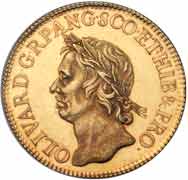 |
Great Britain. Pattern Broad, 1656. S.3225; Fr-273; KM-PN25; WR-39. Reeded edge. By Thomas Simon. Oliver Cromwell. Laureate bust left. Reverse; Crowned arms. The so-called gold Broad, valued in 1656 at 20 shillings, was in effect the very first Guinea, which was invented in the following decade and also valued at 20 shillings. Reflective surfaces with sparkling luster, this specimen has great eye-appeal. Very Rare. Pop 7; 3 in 63; 1 in 64. NGC graded MS-62. Estimated Value $20,000 - UP
"Laureate" bust of the Protector facing left surrounded by his titles in Latin (mostly abbreviations). On the reverse side we see Cromwell's family crest substituting for the traditional royal shield, crowned, dated 1656 at top along rim followed by the Latin legend reading PAX QVAERITVR BELLO ("Peace is Sought by War"), Cromwell's favorite slogan which is seen only on this coin and on the thicker 50-shillings gold coin of the same date. Reeded edge (also called "grained edge").
The only English coin known by this denomination, this beautifully engraved, modern-style coin was of the same "face value" as certain large gold coins of previous monarchs, coins that were made by the hammered process-which this coin made obsolete since it was so much finer looking. That value was its equivalent in 20 silver shillings. A few short years in the future a new denomination, called the guinea, would replace it and become dominant in English economics for a century and a half. The broad was one of the first English coins made by machinery (known as "milled") rather than by the ancient method of striking money using hand-held hammers. The new presses were imported from France by Pierre Blondeau. The dies for the coins were engraved by Thomas Simon. Cromwell's portrait was made modern looking, as well as lifelike, using the "stippled" style of engraving that became a feature of Simon's skills. Never before had English money portrayed the ruler looking as he or she did in life-coins that were perfectly round in shape, consistently sharp in details and gleaming with luster. This coin changed the nature of money in Great Britain.
Ex Goldberg Sale 34, Feb 5, 2006, lot 2238.
View details and enlarged photos
Realized
$90,000 |
|
Lot 1125 |
 |
Great Britain. Five Guineas, 1687. S.3397A; Fr-292. James II, 1685-1688. Second laureate bust. King facing left. Reverse; Crowned cruciform shields. An unusually well struck and lustrous specimen. Pop 2; 1 in 60; 1 in 61. NGC graded AU-58. Estimated Value $20,000 - UP
** All James II coins are rare and as this was a very short (four years) series the reign is numismatically popular. King James II was a complex but rather unexciting character who lived much of his life in the shadow of his more charismatic brother, King Charles II. When their father was facing defeat by the Parliamentary forces during the English Civil War, James escaped from St James's Palace in 1648 and left the country. He married Anne Hyde, daughter of Edward Hyde (later Duke of Clarendon) at The Hague, Netherlands, in August 1659, and returned to England when the monarchy was restored in 1660. Like his brother, he had a string of mistresses - Jane Middleton, Elizabeth Butler Lady Chesterfield, Goditha Price, Margaret Brook Lady Denham, Arabella Churchill, and Catherine Sedley Countess of Dorchester, among others, and a string of illegitimate children!
James converted to Catholicism in the 1660's, but his brother Charles II, fearful of upsetting public opinion, insisted that he should still take the Anglican connunion and that his surviving (legitimate) children (the future monarchs Mary II and Anne) should continue to be instructed as Protestants.
Things were fine until James's wife Anne died in 1671 and in 1673 married the 15 year old Mary of Modena. In 1685 Charles II died and James became King. In 1688 his new Roman Catholic wife, Mary, bore him a Catholic son, and James asked the Pope to stand as godfather! This was a step too far for an English public which was heavily Protestant. At this stage, a group of English magnates - six moneyed lords and a bishop - asked William of Orange, James's son-in-law, to deliver the nation from 'a perpetuation of evil'. William landed in Torbay and James, with his army, advanced to meet him. When James's generals deserted him he fled to Ireland, where he was defeated by William at the Battle of the Boyne in July 1690, and he spent his last years in France. In the meantime, William and Mary assumed the throne as joint monarchs.
Ex Goldberg Sale 34, Feb 5, 2006, lot 2243.
View details and enlarged photos
Realized
$66,000 |
|
Lot 1126 |
 |
Great Britain. Five Guineas, 1693. S.3422; Fr-299; KM-479.1. William and Mary, 1689-1694. Obv: Plain below conjoined busts of monarchs facing right. Legend reads: GVLIELMVS ET MARIA DEI GRATIA with toothed border both sides. Reverse has inverted die axis, fine detail, crowned quartered shield with an escutcheon of the Lin of Nassau with nine lozenges, ten strings to Irish harp, date at top, MAG BR FR ET HIB REX ET REGINA. Edge has inverted inscription in raised letters DECVS ET TVTAMEN ANNO REGNI QVARTO. This coin is very sharply struck with a beautiful prooflike quality, virtually full original luster, small tinges of old red toning and an overall eye appeal which is rarely seen even on the very best of these large gold coins. Pop 4; None Finer at NGC. NGC graded MS-62. Estimated Value $50,000 - UP
The so-called Glorious Revolution which witnessed the departure of the turned-Catholic King James II ended with the selection by the Convention Parliament of James' daughter Mary Stuart and her husband, the former Prince of a small European country. Designs, especially on the reverse sides of coins, were altered considerably from those of James II in order to demonstrate a break in the continuity of England's evolving history-specifically from the Catholic king to the new Protestants who ruled jointly. The idea of placing their images side by side may have been inspired by ancient Greek and Roman coins. In order to assert that royal Mary's husband would have the right of succession, his bust was placed in front of hers but her entire profiled showed. He was nicknamed "the little Dutchman" by the English public and he was welcomed as a result of his former military assistance in defending the nation against aggression and invasion. The dual monarchy, which had commenced in 1689, ended with the much-lamented death of Queen Mary in December 1694. From then until 1702, William reigned alone.
Ex Goldberg Sale 41, May 2007, lot 4517.
View details and enlarged photos
Realized
$138,000 |
|
Lot 1127 |
 |
Great Britain. Guinea, 1700. S.3460; Fr-313; KM-498.1. William III, 1694-1702. Second larueate Bust. Human-shaped harp on shield. Well struck and having gorgeous satiny luster. Rare this nice. Pop 2; 1 in 63. NGC graded MS-62. Estimated Value $3,000 - UP
Ex Goldberg Sale 34, Feb 5, 2006, lot 2246.
View details and enlarged photos
Realized
$13,800 |
|
Lot 1128 |
 |
Great Britain. 'Fine Work' Five Guineas, 1701. S.3456; Fr-310. William III, 1694-1702. Plain Scepters. Second laureate bust right. Reverse; Crowned cruciform shields with plain scepters. Sharply struck example with fine hair detail. The 'Fine Work' gold coins of William III are among the most spectacular of the period. Surfaces are proof like and gleaming with luster. A lovely example with great eye appeal. Pop 4; 4 in 62; 6 in 63. PCGS graded MS-61. Estimated Value $30,000 - UP
The marvelous and deeply engraved portrait of King William on this coin, known as the "fine work" style, appeared only at the end of his reign and only on three of his gold denominations, all dated 1701. It was the last date to appear on any of his money. Each of the three gold coins presented the king wearing a long periwig slightly differently, but the most elegant of the designs was shown on this, the largest denomination. It was remarkably lifelike, even to the king's crooked nose and fine moustache. The reverse side's royal shield reverted from the elegantly Renaissance style of the former dual monarchy's coinage, presenting the more traditional four crowned royal shields in the shape of a "cruciform," each angle displaying a scepter topped by an emblem of the four kingdoms-of England, Scotland, France and Ireland in order from the first to last angle. The bold surrounding legend in Latin abbreviations proclaims William as King of Great Britain, France and Ireland.
The famous Great Re-coinage of the silver money occurred late in this reign, during the middle 1690s, under the watchful eye of the Royal Mint's chief, Sir Isaac Newton, famed scholar and mathematician. It allowed all of the old, damaged and worn silver money to be returned to the Mint without loss of value (in other words, at face) to holders of the money that had lost so much of its real, intrinsic value. Bright new silver sixpence coins and shillings and halfcrowns were minted by the millions, to the relief of the public who now had full confidence in the real value of their money. But the Mint also continued to issue golden money of excellent quality. The whiff of change was in the air, however: the Bank of England's paper money, currency with the full backing of the bank (which had been founded in 1694 during this reign and had been growing in influence steadily until it funded the Crown's governing activities) was going to replace these beautiful large gold coins within six decades. Of all the coins of William III, collectors most cherish this splendidly made coin, worth a fortune in buying power in its day.
Ex Goldberg Sale 41, May 27, 2007, lot 4522.
View details and enlarged photos
Realized
$87,000 |
|
Lot 1129 |
 |
Great Britain. "VIGO" Five Guineas, 1703. S-3561; Fr-183; KM-520.1. 41.69 grams. SECVNDO on edge. Queen Anne, 1702-1714. Draped bust left; VIGO below bust. Reverse; Crowned cruciform arms, with alternating scepters and a central (Tudor) rose. Uncirculated, a wonderful specimen blessed by superb eye appeal, with all details sharp, and complimented by deep, proof-like luster. Scattered faint hairlines (from being in important collector cabinets over the past 300 years). Historical, and excessively rare. Sure looks like a special proof strike. Pop 1; The Finest Proof-Like graded at any service. PCGS graded MS-61 Prooflike. Estimated Value $300,000 - UP
The queen is shown facing left with her long hair curled and tied in a bow, her body draped. Beneath her portrait are the letters VIGO in large capitals. The reverse shows the date at top and consists of the classic "cruciform" composed of the shields of the kingdoms (England, Scotland, France and Ireland), each with a crown over it, a double open rose at center, each angle displaying a scepter topped by an emblem of the four kingdoms-of England, Scotland, France and Ireland in order from the first to last angle. The bold surrounding legend in Latin abbreviations proclaims her Queen of Great Britain, France and Ireland.
For centuries, since the victory at Agincourt in 1415, English kings and queens claimed to be the sovereigns of France, and this appears in their titles as seen on this coin. Bourbon Spain and Catholic France were the oldest enemies of the kingdom. During the 17th and 18th centuries, English buccaneers attacked their ships at sea, attempting to seize treasure, especially gold and silver mined in the New World and being transported back to Spain for that country's coinage. One of the most famous of all seizures occurred near the beginning of Queen Anne's reign, in October 1702. England and the Dutch Republic were allies against their common enemies. Sir George Rooke of the British navy was in command of some 50 warships that attacked a treasure fleet returning from South America anchored at Vigo Bay on the northwest coast of Spain. It consisted of three Spanish treasure galleons protected by French warships. Rooke and his fleet of warships entered the bay, breaking through a huge boom of heavy chain and timber that stretched across the entrance to the bay, sailed straight at the moored ships, and a furious battle took place inside the harbor. After a day and a half, the enemies' ships had been almost all destroyed and Rooke's marines seized the one treasure galleon remaining at the port. They were startled to discover that most of the specie had been unloaded and carted away before they had arrived, but what remained was no small prize. It consisted of more than two tons of silver, but just a few pounds of gold. It was all hauled back to England aboard Rooke's ships, arriving at the mint inside the Tower of London. The queen commanded that the word VIGO be placed under her portrait on all coins made from this captured treasure, in part to mock their enemies but also to use these coins as patriotic symbols. Thousands of English silver coins so marked circulated to serve this purpose, but the prize was also much needed because silver was in short supply. The small amount of captured gold was coined into half-guineas, guineas, and five-guineas pieces, most of which were paid to the officers and sailors who had taken part in the sea battle, and those coins seem to have been almost all spent at the time; in later years, many were melted. All are very rare today, but especially the biggest coin, the 1703-VIGO five-guineas, and especially this truly stunning coin. It would be a prize in any collection.
Ex Murdock 1903, lot 834. Only 15-20 specimens known, and this is reputedly the finest. With diagnostic lint mark on the scepter of the fourth quarter of the cruciform. Most numismatists believe the 1703 VIGO Five Guineas to be the rarest of all English gold coins. This coin was the sole cover illustration of the 2003 edition of Spink's Standard Catalogue of British Coins: Coins of England and the United Kingdom, London, 2002; Illustrated in Money of The World, coin 105; Ex Goldberg 'Millennia' Sale, 46, May 26, 2008, lot 354.
View details and enlarged photos
Realized
$900,000 |
|
Lot 1130 |
 |
Great Britain. Crown, 1703. S.3576; Dav-1338. Anne, 1702-1714. VIGO below bust. Draped bust of Queen facing left. Pre-Union (with Scotland) shields on reverse. Plain in angles. Regnal year TERTIO in raised letters on edge. Once lightly cleaned with lots of original mint luster remaining and good eye-appeal. Lightly toned one-year historic type coin, rare in high grade. PCGS graded Uncirculated Detail (Cleaned). Estimated Value $3,500 - UP
The Anglo Dutch naval expedition seized Spanish bullion in Vigo Bay. Where this was used to make silver coin, the word VIGO was placed below the Queen's head. The early part of Anne's reign was one of several naval and military skirmishes. the Battle of Blenheim (1704) largely won by John Churchill, Duke of Marlborough, and fought against the French and her allies involved armies totalling 116,000 men. Anne's was a reign of scientific and intellectual progress, the first daily newspaper appeared in London, literature and the arts flourished and elegant furniture was made. There was even the establishment of horse racing at Ascot.
Ex Goldberg Sale 34, Feb. 7, 2006, lot 2684.
View details and enlarged photos
Realized
$5,520 |
|
Lot 1131 |
 |
Great Britain. Five Guineas, 1706. S.3566; Fr-317; KM-521. Queen Anne. After Union with Scotland. Bust left. Reverse; The shields on the reverse are changed to Post-Union type. Faint obverse adjustments on bust. Sharply struck with reflective and lustrous fields. Pop 5; 3 graded higher; 2 in 62; 1 in 63. NGC graded MS-61. Estimated Value $30,000 - UP
Ex Goldberg Sale 36, May 28, 2006, lot 1208.
View details and enlarged photos
Realized
$132,000 |
|
Lot 1132 |
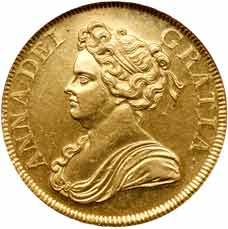 |
Great Britain. Five Guineas, 1714/3. S-3568; Fr-317; KM-535. Queen Anne, 1702-1714. Post-Union type. Draped bust left. Reverse: Crowned cruciform arms, with alternating scepters at angles, Garter star at center. An exceptionally choice-looking piece with a sharp strike showing nearly complete hair detail, and minimal marks on the broad, open surfaces that glitter with prooflike luster. Extremely rare in this grade. Among the finest known examples of this impressive, large gold type, this may as well be at the very top of the census for this overdate. Pop 2; Only 2 graded at NGC. Maybe the same coin? NGC graded MS-62 Prooflike. Estimated Value $50,000 - UP
Ex Goldberg "Millennia" Sale 46, May 26, 2007, lot 360.
View details and enlarged photos
Realized
$186,000 |
|
Lot 1133 |
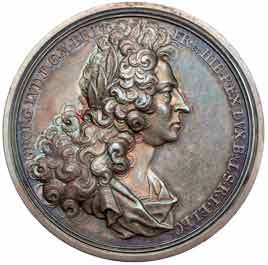 |
Great Britain. Medal, 1714. Med Ill volume 2, p.421,4. Silver. 44 mm. 29.64 grams. Plain edge. By Georg Wilhelm Vestner, a medallist of Nuremberg. George I, 1714-1727. For the Accession. Bust of George I, laureate long hair right. Reverse; The Sun in the midst of the constellation Leo. A lovely executed medal in high relief. Beautiful old tone. Pop 1; None Finer at NGC. NGC graded MS-63. Estimated Value $1,500 - UP
Ex Goldberg Sale 42, Sept 27, 2007, lot 424.
View details and enlarged photos
Realized
$7,800 |
|
Lot 1134 |
 |
Great Britain. Five Guineas, 1726. S.3626; Fr-325. George I, 1714-1727. Laureate head of King facing right. Reverse; Sceptres and shields. Regnal year (DECIMO TERTIO) on edge in raised letters. A nice glossy example with an unusual absence of surface marks or knocks. George I Fine Guineas are the rarest - only the patterns of the reign of King George III are rarer. NGC graded About Uncirculated Detail (Cleaned). Estimated Value $25,000 - UP
George I was born in 1660 and his parents were the Elector of Hanover and Sophia, the granddaughter of King James I of England (James VI of Scotland). He came to the English throne because Parliament preferred him to James Edward Stuart - the half-brother of Queen Anne. He could not however speak English and spent over half his reign in Germany. Ironically, he kept England at peace for the whole of his reign.
Ex Goldberg Sale 34, Feb. 7, 2006, lot 2251.
View details and enlarged photos
Realized
$48,000 |
|
Lot 1135 |
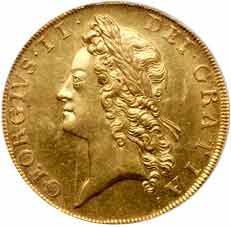 |
Great Britain. Five Guineas, 1729. S.3663; Fr-332. George II, 1727-1760. Young laureate head of King facing left. Reverse; Crowned shield of arms. Edge year TERTIO in raised letters on edge. Crisply struck and prooflike with a light orange perimeter tone. This is a slightly scarcer date, but excessively rare in this high grade. Remarkably free of any surface marks or striations associated with large gold coins of this period. Truly an extra special specimen and a handsome companion to the 1748 5 Guineas offered here. Pop 2; 1 in 64. This coin photo in the PCGS Pop Report. PCGS graded MS-62. Estimated Value $30,000 - UP
Ex Goldberg Sale 34, Feb 5, 2006, lot 2252.
View details and enlarged photos
Realized
$78,000 |
|
Lot 1136 |
 |
Great Britain. Five Guineas, 1748. S.3666; Fr-334. George II, 1727-1760. Old laureate bust of King facing left. Reverse; Crowned shield of arms. Edge year VICESIMO SECUNDO in raised letters on edge. Design frosted and fields proof like under a light orange tone. The most insignificant of metal striations. The edge has a satin finish. It is possibly a specimen striking. Pop 1; The Finest graded at PCGS. This coin photo in the PCGS Pop Report. PCGS graded MS-64. Estimated Value $40,000 - UP
This coin was sold some 30 years ago, when it was described by London dealers Spink as 'practically flawless, a superb specimen, as struck, and rare thus'. Certainly the coin has a wonderful reflective quality and a crispness of strike which is hardly ever seen on coins of this period. An irreplaceable addition to a top quality collection of British gold coins, this is one of the most attractive large English milled gold coins we have ever seen.
Ex Goldberg Sale 34, Feb 5, 2006, lot 2254.
View details and enlarged photos
Realized
$204,000 |
|
Lot 1137 |
 |
Great Britain. Half Guinea, 1762. S.3731; Fr-358; KM-593. Geroge III. First laureate head. Sharply struck with an abundant of original mint luster. Exceptionally pretty old-gold color. Among the finest known of this elusive two year type issue. Very Rare. Pop 1; 2 in 65. NGC graded MS-63. Estimated Value $5,000 - UP
Ex Goldberg Sale 34, Feb 5, 2006, lot 2257.
View details and enlarged photos
Realized
$9,300 |
|
Lot 1138 |
 |
Great Britain. Pattern Proof Half Guinea, 1763. WR-127 (Rarity-4); DM-84 (this same coin). George III. Engraved by Yeo. Plain edge. Short-haired laureate head, curls over the left shoulder. Very few tiny abrasions but still a most pleasing, brilliant specimen. Very important and excessively rare. Pop 1; The only one graded at NGC. NGC graded Proof 62. Estimated Value $5,000 - UP
Ex Goldberg Sale 34, Feb 5, 2006, lot 2258.
View details and enlarged photos
Realized
$19,200 |
|
Lot 1139 |
 |
Great Britain. Pattern Half Guinea, 1764. W&R-128 (R5). George III, 1760-1820. Plain edge. By Yeo. Second laureate head right. Reverse; Crowned shield of arms. Extremely rare. PCGS graded Proof 63. Estimated Value $5,000 - UP
As is often the case when a new monarch ascends the throne, there is a run of patterns from the opening years of the reign of George III. The present specimen is of the same design as that adopted for the currency and as such is a proof, although the type is still referred to as a pattern by some sources. The design has, in the past, been attributed to Tanner.
Ex Herman Selig; Ex Douglas-Morris; possibly Ex Capt. Vivian Hewitt and Nobleman; Ex St. James's Auction 2, May 11, 2005, lot 353.
View details and enlarged photos
Realized
$21,000 |
|
Lot 1140 |
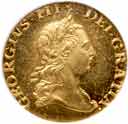 |
Great Britain. Half Guinea, 1769. S.3732; Fr-359; KM-599. George III. Second head. Boldly struck with beautiful reflective surfaces and dazzling luster. A truly stunning coin, and very rare in this condition. Pop 1; The Finest graded at NGC. NGC graded MS-65. Estimated Value $3,000 - UP
Ex Goldberg Sale 34, Feb 5, 2006, lot 2260.
View details and enlarged photos
Realized
$10,500 |
|
Lot 1141 |
 |
Great Britain. Pattern Farthing Struck in Gold, 1797. Peck-1191 (EXR). 9.2g. Restrike. George III, 1760-1820. The elderly king is depicted facing to the right, his body draped, his hair laureate. In classic Soho Mint style, the portrait is centered within a recessed circle. On the reverse, Britannia is shown seated facing left, SOHO mint name on a rock behind her, all within a recessed center. Edge is plain. A brilliant example of this great rarity. Pop 1; The only one graded at PCGS. PCGS graded Proof 63 Deep Cameo. Estimated Value $15,000 - UP
Beginning in the 1780s, Matthew Boulton and James Watt revolutionized Great Britain's coinage, indeed altered the very nature of its hard money. Boulton owned a button manufactory in Birmingham but he was more than an industrialist; he was a man of vision and an entrepreneur in every fiber of his body. Acutely aware of the depressed state of the coinage that was circulating in the 1780s, he decided to team up with Watt, inventor of the steam engine who held important patents, and the pair commenced upon their greatest of many achievements: establishment of the Soho Mint. Watt modified his invention so as to work in a new way, moving its functional parts up and down, rapidly, as powered by steam. It could pound out buttons (and coins!) faster and better than had ever been possible, with perfect accuracy. Boulton put his entire manufactory at the disposal of their new enterprise. They began with a tentative pattern halfpenny coinage in the late 1780s. It and subsequent, boldly struck coins made on contract so impressed the officers of the king's Royal Mint that Boulton and Watt won important contracts to make a series of entirely new-looking, modernistic copper coins-including the first-ever copper penny, dated 1797. The enthusiastic acceptance of their copper farthings, halfpennies and pennies led to a contract to create temporary money in the late 1790s by over-striking foreign silver coins, and eventually to the creation of the uniquely styled 1804 Bank Dollars. These coins saved an economy that was faltering because of extreme lack of both silver and copper money. Aside from millions of such coins made to enter commerce, the Soho Mint also created some of the finest proof coins for collectors. Dozens of patterns and proofs came from the proofing presses of the Soho Mint, in a variety of metals. After Soho closed its doors in the 1820s, an enterprising dealer in antiques purchased some of Soho's old dies and re-struck pieces for collectors. Mostly these were minted very carefully in the first few decades of the 19th century. Copper, sometimes bronzed, sometimes gilt, was the most used metal for these now-celebrated re-issues. Silver strikes were made only occasionally, thus quite rare. Gold pieces were the rarest, originally intended for the collections of wealthy men, often friends of Boulton who requested specially made coins. The glorious gold farthing seen here is one of those.
Ex Spink, London, private treaty, May 2005.
View details and enlarged photos
Realized
$39,600 |
|
Lot 1142 |
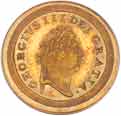 |
Great Britain. Pattern Half Guinea, 1798. W&R-132 (R7). By Pingo. George III. Small laureate head right, within raised border. Reverse; Crowned, oval cruciform shields. Only one or two specimens known. Pop 1; The Finest of two graded at PCGS. PCGS graded Specimen 65. Estimated Value $10,000 - UP
The only specimen the cataloguer has seen
The extraordinary reverse design with its oval shields and sunken border is like nothing seen on the adopted coinage either before or since. It does however, with its incuse numerals and delineated borders, echo the contemporary designs of Küchler used on the copper 'Cartwheel' coinage of 1797.
Ex Farouk; Ex Murdoch; Ex Montagu; Ex Brice; Ex St. James's Auction 2, May 11, 2005, lot 360.
View details and enlarged photos
Realized
$48,000 |
|
Lot 1143 |
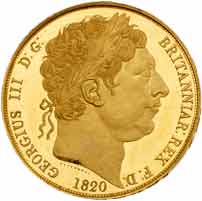 |
Great Britain. Pattern Five Pounds, 1820 LX. W&R-177 (R4); L&S-207; S.3783. 39.85g, toothed border both sides, edge inscribed. By Benedetto Pistrucci. George III, 1760-1820. Obv. Large laureate head right, pistrucci below, GEORGIUS III D:G: - BRITANNIAR: REX F:D: 1820. Reverse; Inverted die axis, St. George and the dragon, pistrucci in exergue, w.w.p. above broken lance on groundline, edge upright lettering DECUS ET TUTAMEN*ANNO REGIN LX*, rosette stops. Extremely rare, only 25 specimens struck. Pop 3; 1 in 64+DCam. A total of seven graded at PCGS. Some could be duplicates. This example photo in the PCGS Pop Report. PCGS graded Proof 63 Deep Cameo. Estimated Value $150,000 - UP
"Laureate Head" portrait facing right, king's name in Latin and royal titles around the rim with the date beneath. The designer has spelled out his name in tiny capital letters immediately under the king's portrait. Reverse presents the touched-up image created by Benedetto Pistrucci (modified by William Wyon) showing Saint George on horseback, naked but for a Roman-style helmet with streamer, cape and boots. Below the horse is Evil incarnate, or the Devil, represented by a dragon, speared through its side and being trampled by the horse. Part of the broken spear is shown on the ground. Saint George holds a sword in his right hand, which is the update of the earlier style. There is no legend, only the designer's name spelled out in tiny capital letters at left under the ground-line. The coin's edge features in raised letters the classic slogan DECUS ET TUTAMEN (meaning "An Ornament and a Safeguard") and ANNO REGNI LX, standing for year 60 of the reign.
The late-reign patterns of £5 and £2 value (five sovereigns and two sovereigns in value respectively) dated 1820 are among the most desirable of all 19th-century patterns. The elderly king is portrayed by the engraver Pistrucci as a Roman-style emperor in all his glory, despite the reality of his condition. This image has been called a memorial to the king in the 60th year of his reign and a celebration of the New Coinage of 1816-20. The same design with slight modifications was used for both patterns. Very few pieces have plain edges; most have lettered edges-the legend noted on each. Neither denomination was ever intended to be issued as a circulating coin-each size replaced in usefulness by paper currency more than half a century earlier. Quite a few splendid patterns struck in gold were created during this reign but these must be considered to be among the very finest. Engraving them had been authorized in the summer of 1816 but the dies were not completed until almost the exact moment of George III's death. Each version is very rare: some 25 with lettered edges were made of the larger denomination £5 and 60 of the £2 size. All pieces were distributed at the time to officials at the mint, national museums and prominent collectors. Their enduring appeal is the artistic purity of the designs-bold, crisp and free of cluttered legends. Their beauty is spectacular and their appeal to the world's collectors never-ending.
Ex Spink, London, May 5, 2005, lot 193.
View details and enlarged photos
Realized
$480,000 |
|
Lot 1144 |
 |
Great Britain. Pattern Five Pounds, 1820, LX. W&R-178 (R5); L&S-209; S.3783. 39.88g. Plain edge with bevelled rims. By Benedetto Pistrucci. George III, 1760-1820. Obv. Large laureate head right, pistrucci weakly struck below, GEORGIUS III D:G: - BRITANNIAR: REX F:D: 1820, finely toothed border both sides. Reverse; Struck en medaille, St. George and the dragon, pistrucci in exergue, w.w.p. above broken lance on ground line. Exceedingly Rare, only two specimens struck. Pop 1; The only Example graded at PCGS. PCGS graded Proof 61 Cameo. Estimated Value $150,000 - UP
The late-reign patterns of £5 and £2 value (five sovereigns and two sovereigns in value respectively) dated 1820 are among the most desirable of all 19th-century patterns. The elderly king is portrayed by the engraver Pistrucci as a Roman-style emperor in all his glory, despite the reality of his condition. This image has been called a memorial to the king in the 60th year of his reign and a celebration of the New Coinage of 1816-1820. The same design with slight modifications was used for both patterns. Very few pieces have plain edges; most have lettered edges-the legend noted on each. Neither denomination was ever intended to be issued as a circulating coin-each size replaced in usefulness by paper currency more than half a century earlier. Quite a few splendid patterns struck in gold were created during this reign but these must be considered to be among the very finest. Engraving them had been authorized in the summer of 1816 but the dies were not completed until almost the exact moment of George III's death. Each version is truly rare: some 25 with lettered edges were made of the larger denomination £5, and 60 of the £2 size. All pieces were distributed at the time to officials at the mint, national museums and prominent collectors. Their enduring appeal is the artistic purity of the designs-bold, crisp and free of cluttered legends. Their beauty is spectacular and their appeal to the world's collectors never-ending.
Ex J G Murdoch, Sotheby, 15 March 1904, lot 175; Mortimer Hammell, Stacks, New York, 15 September 1982, lot 356; H Selig, Part 2, Spink Coin Auction 131, 2nd March 1999, lot 1159; Spink, London, May 5, 2005, lot 194.
View details and enlarged photos
Realized
$336,000 |
|
Lot 1145 |
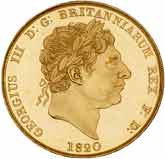 |
Great Britain. Pattern Two Pounds, 1820 LX. W&R-179 (R3); L&S-207 note; S.3784. 15.93g. By Benedetto Pistrucci. George III, 1760-1820. Obv. Laureate head right, date below, GEORGIUS III D:G; BRITANNIARUM REX F:D:, finely toothed border both sides. Reverse; Inverted die axis, St. George and dragon, W.W.P. under broken lance, small B.P. to upper right of exergue, edge upright inscription in raised letters DECUS ET TUTAMEN * ANNO REGNI LX*, rosette stops. Very rare, only sixty specimens struck. Pop 1; the only Example graded at PCGS. PCGS graded Proof 62 Deep Cameo. Estimated Value $30,000 - UP
"Laureate Head" portrait facing right, the king's name in Latin and his royal titles around the rim and date beneath. On the reverse we see the iconic image created by Benedetto Pistrucci (later touched up by William Wyon) showing Saint George on horseback, naked aside from a Roman-style helmet with a streamer, cape and boots. Below is the Devil incarnate, represented by a dragon, speared through its side and being trampled by the horse. Part of the broken spear is shown on the ground. Saint George holds a sword in his right hand, which is one detail of Wyon's update of the earlier style. There is no legend, only the initials "B.P." in the exergue under the dragon, the signature of the engraver Pistrucci. On some 2-pounds of 1820, the edge is plain while on others the edge features in raised capital letters the classic slogan DECUS ET TUTAMEN (originally intended to frustrate shaving gold off the edge-in English meaning "an ornament and a safeguard") and ANNO REGNI LX, standing for year 60 of the reign.
Ex Spink, London, May 5, 2005, lot 195.
View details and enlarged photos
Realized
$56,400 |
|
Lot 1146 |
 |
Great Britain. Pattern Proof Half Sovereign, 1821. WR-243 (Rarity-6, just 3 to 5 known); DM-149. George IV, 1820-1830. Laureate head left. Reverse; Crowned, square-topped shield, with a spray of thistle, rose and shamrock below. Reverse style used from 1823 to 1825 on the currency issues. Superb Choice Proof with a moderate cameo. A major opportunity for the specialist in rare British pattern gold. Pop 1; The only Proof Cameo graded at NGC. NGC graded Proof 64 Cameo. Estimated Value $5,000 - UP
Ex Goldberg Sale 34, Feb 5, 2006, lot 2277.
View details and enlarged photos
Realized
$48,000 |
|
Lot 1147 |
 |
Great Britain. Proof Five Pounds, 1826. S.3797; Fr-373; WR-213; KM-702. George IV, 1820-1830. Bare Head left. Reverse; Crowned shield and mantle. Lettered Edge. Issued in a set and a proof only issue with a reported mintage of only 150. Truly superb example having a most impressive eye appeal. Pop 4; 1 in 64Cam; 1 in 65+Cam; 1 in 67Cam. PCGS graded Proof 63 Cameo. Estimated Value $100,000 - UP
This beautiful coin was the largest gold piece and highest denomination in the second set of proof coins issued in this brief reign (1820-30). The young king, a flamboyant man by anyone's standards, so disliked his first portrait (the "Laureate Head") that he ordered his mint to copy a famous marble statue of him, producing the image seen here. It was a mostly accurate depiction of the man he wished himself to be, even though at this age he had over-indulged in food, drink and drugs-all of which, in combination, caused his early death. For years before his accession, he had been the Prince Regent of England, beginning with the incapacitation of his elderly father, King George III, in 1787. Although married, he died without heir, long estranged from his wife. He did leave behind prizes such as this fabulous coin from his personally favored proof set.
Ex St. James's Auction 2, May 11, 2005, lot 392.
View details and enlarged photos
Realized
$114,000 |
|
Lot 1148 |
 |
Great Britain. Proof Two Pounds, 1826. S.3799; WR-228; Fr-374; KM-701. Lettered edge. George IV, 1820-1830. Bare head left, date below, GEORGIUS IV DEI GRATIA. Reverse; Quartered shield of arms with an escutcheon of the Arms of Hanover upon crowned ermine mantle, BRITANNIARUM REX FID: DEF. A mintage of a mere 450 pieces. Sure looks cameo. Pop 6; 6 in 64. PCGS graded Proof 63. Estimated Value $10,000 - UP
Ex Spink, London, May 2005.
View details and enlarged photos
Realized
$18,600 |
|
Lot 1149 |
 |
Great Britain. Proof Sovereign, 1826. S-3801; WR-237; Fr-377A; KM-696. George IV, 1820-1830. Second bare head left, date below, GEORGIUS IV DEI GRATIA. Reverse; Quartered shield of arms with an escutcheon of the Arms of Hanover upon crowned ermine mantle, BRITANNIARUM REX FID: DEF. Superb example. Pop 2; 1 in 66Cam; 1 in 67Cam. This coin photo in the PCGS Pop Report. PCGS graded Proof 65 Cameo. Estimated Value $10,000 - UP
Ex Spink, London, May 2005.
View details and enlarged photos
Realized
$25,200 |
|
Lot 1150 |
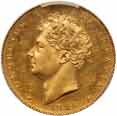 |
Great Britain. Proof Half Sovereign, 1826. S-3804A; WR-249; Fr-380a; KM-700. George IV, 1820-1830. Bare head left, date below, GEORGIUS IV DEI GRATIA. Reverse; Garnished crowned shield, BRITANNIARUM REX FID: DEF. Sure looks cameo. Pop 7; 4 in 64; 3 in 65. PCGS graded Proof 63. Estimated Value $3,500 - UP
Ex Spink, London, May 2005.
View details and enlarged photos
Realized
$9,600 |
|
Lot 1151 |
 |
Great Britain. Proof Crown, 1826. S.3806; ESC-257; KM-699. George IV, 1820-1830. Obverse, bare of king left. GEORGIUS IV DEI GRATIA, date below. Reverse; Ornate crowned Hanoverian shield and mantle, BRITANNIARUM REX FID: DEF: Edge inscribed in raised letters: DECUS ET TUTAMEN ANNO REGNI SEPTIMO. Deep iridescent toning. Pop 14; 21 Finer at PCGS. PCGS graded Proof 63. Estimated Value $10,000 - UP
Perhaps the most beautifully toned 1826 crown anyone could wish to own, this gorgeous coin was the largest silver denomination in the 1826 Proof Set featuring the new portrait of King George IV, based on a marble statue of him which he personally demanded be copied for his coinage-replacing the earlier Laureate Head issues. Exact mintage was never recorded (apparently) but it is believed to have been about 400 pieces. If you are seeking a crown that everyone will envy, this is the coin for you!
Ex Spink, London, May 2005.
View details and enlarged photos
Realized
$18,600 |
|
Lot 1152 |
 |
Great Britain. Proof Half Crown, 1826. S.3808; ESC-647; KM-695. George IV, 1820-1830. Bare head left, date below, GEORGIUS IV DEI GRATIA. Reverse; Garnished crowned shield, BRITANNIARUM REX FID: DEF. Lovely golden toning. Pop 3. None Finer at PCGS. This coin photo in the PCGS Pop Report. PCGS graded Proof 65. Estimated Value $5,000 - UP
Ex Spink, London, May 2005.
View details and enlarged photos
Realized
$6,300 |
|
Lot 1153 |
 |
Great Britain. Proof Two Pounds, 1831. S.3828; Fr-382; KM-718. William IV, 1830-1837. Bare head of the King facing right. Reverse; Crowned shield of arms and mantle. There were no 1831 £5 pieces, the £2 piece is the highest denomination coin struck in the reign of William IV. This is a one-year type coin. Rare. Pop 7; 1 in 63+; 7 in 64; 1 in 64+; 1 in 65+. PCGS graded Proof 63 Deep Cameo. Estimated Value $15,000 - UP
This wonderful coin was the largest denomination in the 1831 Coronation Proof Set, which was the first-ever such set issued by the Royal Mint for collectors. The few earlier, proof sets occurred in years other than the coronation year. Exact mintage has never been established but for the entire set (of gold, silver and copper proofs) the mintage is believed to be about 225. The portrait was engraved by William Wyon, by then the Chief Engraver at the mint; the splendid royal shield on the reverse was the work of J.B. Merlen of the mint, whose specialty for years was engraving splendid reverses for various monarchs. The specimen ranks among the best preserved, most pieces from the sets having suffered hairlines and nicks from poor handling. This specimen is truly regal.
Ex Baldwin St. James's Auction 2, Nov 5, 2005, lot 407.
View details and enlarged photos
Realized
$42,000 |
|
Lot 1154 |
 |
Great Britain. Official Coronation Gold Medal, 1831. William IV Official Coronation Gold Medal. BHM-1475; Eimer-1251. 33 mm. 27.2g. Official Royal Mint issue. By W. Wyon. Plain edge. William IV, 1830-1837. Signed "W. Wyon F" on both sides below portraits of William and Queen Adelaide, both facing to the right. "WILLIAM THE FOURTH CROWNED SEP : 8 1831." Reverse legend reads "ADELAIDE. QUEEN CONSORT. CROWNED SEP : 8 1831." Full brilliant mirror fields with good eye-appeal. Rare. Pop 1. NGC graded Proof Detail (Cleaned). Estimated Value $5,000 - UP
Ex Baldwin St. James's Auction 2, Nov 5, 2005, lot 409.
View details and enlarged photos
Realized
$6,300 |
|
Lot 1155 |
 |
Great Britain. Proof Pattern Sovereign, 1837. KM-Unl., S-Unl., W&R-295 (R5). Plain edge. By William Wyon, reverse by Jean-Baptiste Merlen. Victoria, 1837-1901. Young head left, date below, between rosettes. Reverse; Crowned shield of arms within wreath. A charming coin, seldom seen these days, very rare. Pop 3; None Finer at PCGS. This coin photo in the PCGS Pop Report. PCGS graded Proof 63 Deep Cameo. Estimated Value $20,000 - UP
This wonderful coin was one of several prototypes for the series of sovereigns issued for commerce beginning in 1838, and for proofs of 1839's coronation set. It was the work of two great designer/engravers at the Royal Mint-William Wyon's portrait of Victoria combined with J.B. Merlen's classic shield reverse. This pattern was created in the year of young Victoria's accession, before her coronation. Other pattern sovereigns are dated 1838. It is known that Victoria was personally involved in the creation of her early coins-mindful that her image should appear graceful to her subjects across the kingdom. She had nothing to worry about because William Wyon was a perfectionist who first made a wax model of her portrait from which he engraved dies; he spent considerable time attempting to arrive at an ideal image which would please the queen (as demonstrated by the several patterns he made of this style, varying in size and positioning). For the issued coinage, the two little roses were omitted from the obverse around the date even though, as a spacing flourish, they were a lovely decoration that gave balance to the entire design. Clearly the young queen was pleased-the portrait of her became a classic that appeared on many denominations from 1838-1887.
Ex Baldwin St. James's Auction 2, Nov 5, 2005, lot 630.
View details and enlarged photos
Realized
$81,000 |
|
Lot 1156 |
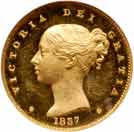 |
Great Britain. Pattern Sovereign, 1837. WR-298. DM-200. By William Wyon. Victoria, 1837-1901. "W.W." incuse; tiny roses to sides of date. The reverse shield by Merlen. Plain edge. Smaller young head left. Reverse; Crowned shield within filleted laurel wreath; rose, shamrock and thistle spray below. R6, extremely rare (only 3 to 5 known). The portrait of Victoria, as a young girl, is fairly well frosted, producing a pleasing cameo of the queen. The mirrors show a splendid brilliance, but there are a few tiny scratches in the obverse field and light scuffs on the portrait; the reverse is simply perfect. Finer than the Douglas-Morris plate coin! Pop 1; 1 in 63+; 1 in 64. Only 3 graded at NGC. NGC graded Proof 63 Ultra Cameo. Estimated Value $20,000 - UP
Struck in the year of Victoria's ascendancy, and one of only a few coins of her reign bearing this date.
Ex Dr Jacob Y. Terner Collection; Ex Goldberg 'Millennia' Sale, 46, May 26, 2008, lot 443.
View details and enlarged photos
Realized
$63,000 |
|
Lot 1157 |
 |
Great Britain. Pattern Bonomi Crown, 1837. ESC-2617 (R3) (323A). Victoria, 1837-1901. Struck in Aluminum. Plain edge, no number. Obverse; Incuse portrait of Queen Victoria left. Reverse; Britannia standing. Very attractive specimen. Extremely Rare. PCGS ID#945759.63 does not appear on the Pop Report. Our piece is probably the only example graded at PCGS. PCGS graded Proof 63. Estimated Value $4,000 - UP
The famous 1893 incuse-design piece which was a mystery to collectors for some years when it first appeared on the market. To some extent, it remains mysterious. Known in a variety of metals, with a total mintage among them probably in the range of 200 to 300 pieces, this "pattern" was apparently the invention of a gentleman named Joseph Bonomi. The story is well told in Linecar & Stone's book, derived from an article in the Numismatic Circular by Captain Pridmore. Bonomi it seems was an Eqyptian traveler and antiquarian, member of the Numismatic Society of London in 1837, who believed that coins would wear less if their design were incuse, rather than raised, an idea that would take form in American gold quarter eagles and half eagles starting in 1908, by designer Bela Lyon Pratt. Bonomi supposedly conceived the Queen and Britannia in a style that suggested an Egyptian motif, which of course was extremely popular in the 1830s. How the master dies were created, and exactly when and by whom, remains indefinite. However, dies were sunk by Theophilus Pinches (probably in 1893) and coins offered for sale in May 1893 by Rochelle Thomas. It is from the latter's ad offering these for the first time that most of what we know about them comes. However, he took license with certain facts to make them more desirable. ESC lists the various metals in which this piece was struck. Those that were numbered bear a number on their edge of from 1 to 150. Whatever is the truth behind these curious coins, and when precisely they were made (1887 to 1893 or even afterwards), is of little consequence today. They are accepted among the patterns of Queen Victoria by most collectors simply because of their stark beauty. Most specimens are not very well preserved, unfortunately. The present crown is among the finest seen by the cataloguer, bright and "fresh." In our opinion, the grading service did not understand the striking procedure of this pattern and the grade assigned should have been somewhat more generous. This is a rare opportunity to acquire one of the more alluring Victorian numismatic items, something very few collectors indeed can claim among their holdings. Extremely rare, and very desirable!
Ex Spink, London, May 2005.
View details and enlarged photos
Realized
$21,000 |
|
Lot 1158 |
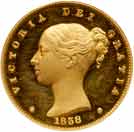 |
Great Britain. Pattern Gold Proof Sovereign, 1838. WR-299. DM-201 (same coin?). By William Wyon. Victoria, 1837-1901. "W.W." incuse; tiny roses to sides of date. Plain edge. Smaller young head left. Reverse: Crowned shield within filleted laurel wreath; rose, shamrock and thistle spray below. Edge of irregular thickness, with knife rims. The digit "3" broken at top of curve. R5, extremely rare (6 to 10 known). A lovely Proof, superb deep cameo, red iridescence. Despite the light abrasions this coin has a marvelous eye appeal. Pop 1; 1 in Pf62+; only 2 graded at NGC. NGC graded Proof 63 Ultra Cameo. Estimated Value $20,000 - UP
This later pattern features a slightly larger young head facing left, with no decorative roses to its sides (those were restricted to the patterns), legend simply declaring Victoria queen DEI GRATIA ("By the Grace of God"). The reverse side features the crowned, elegantly styled, square-topped royal shield of the House of Hanover, its quarters holding the insignia of the kingdoms (England displayed twice), surrounded by a wreath of laurel branches, and beneath it the emblem "spacer" consisting of a rose, thistle and shamrock with a small rose on each side in the field-just as it appeared on the pattern sovereigns of 1837. Along the rim is a Latin legend that translates to mean "Queen of Britain, Defender of the Faith." This reverse style was employed on millions of sovereigns minted beginning in 1838 and used constantly for decades. No example could be finer than this superbly preserved, very rare proof-the final prototype for all the others.
Ex Dr Jacob Y. Terner Collection; Ex Goldberg 'Millennia' Sale, 46, May 26, 2008, lot 444.
View details and enlarged photos
Realized
$54,000 |
|
|
|